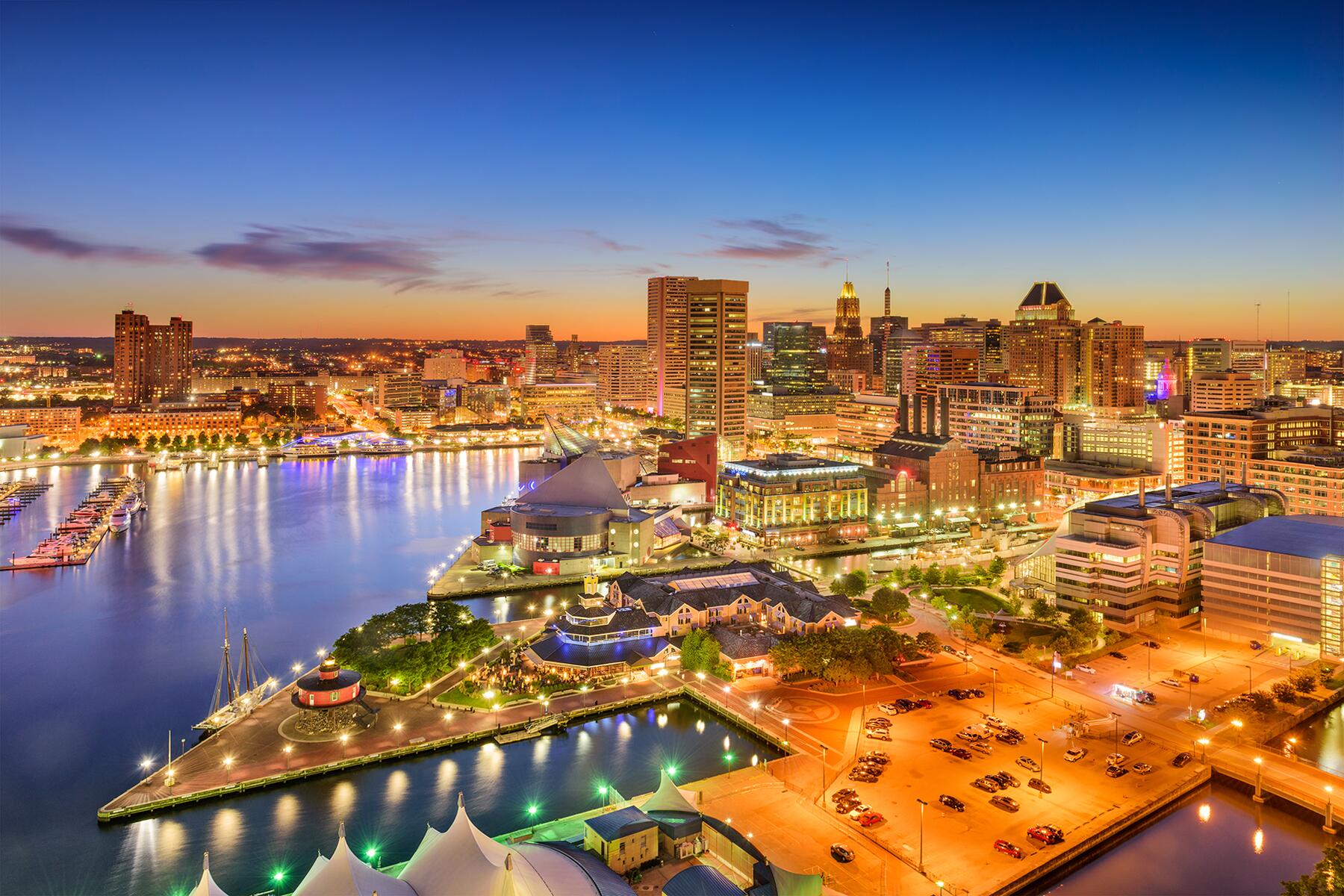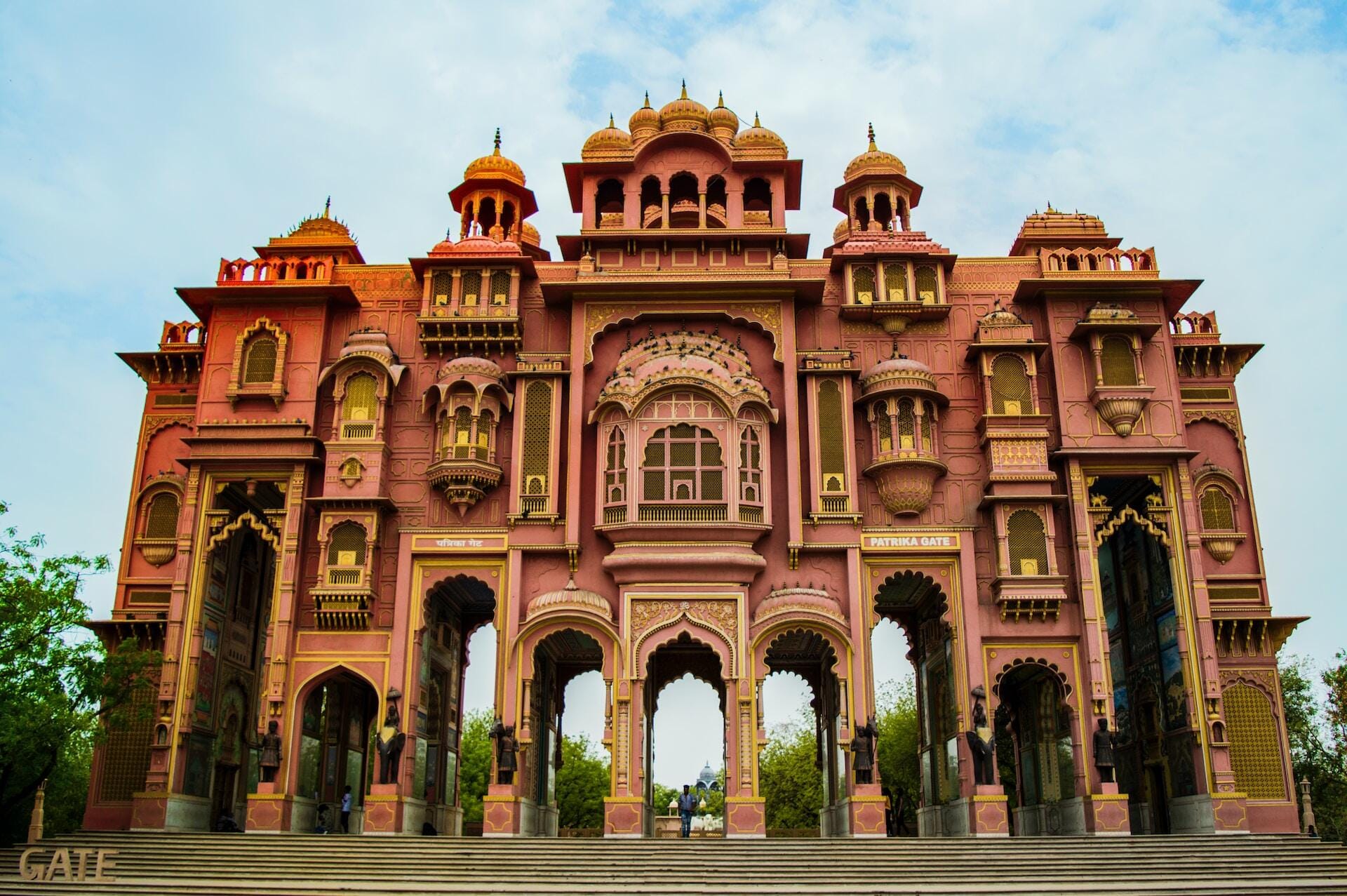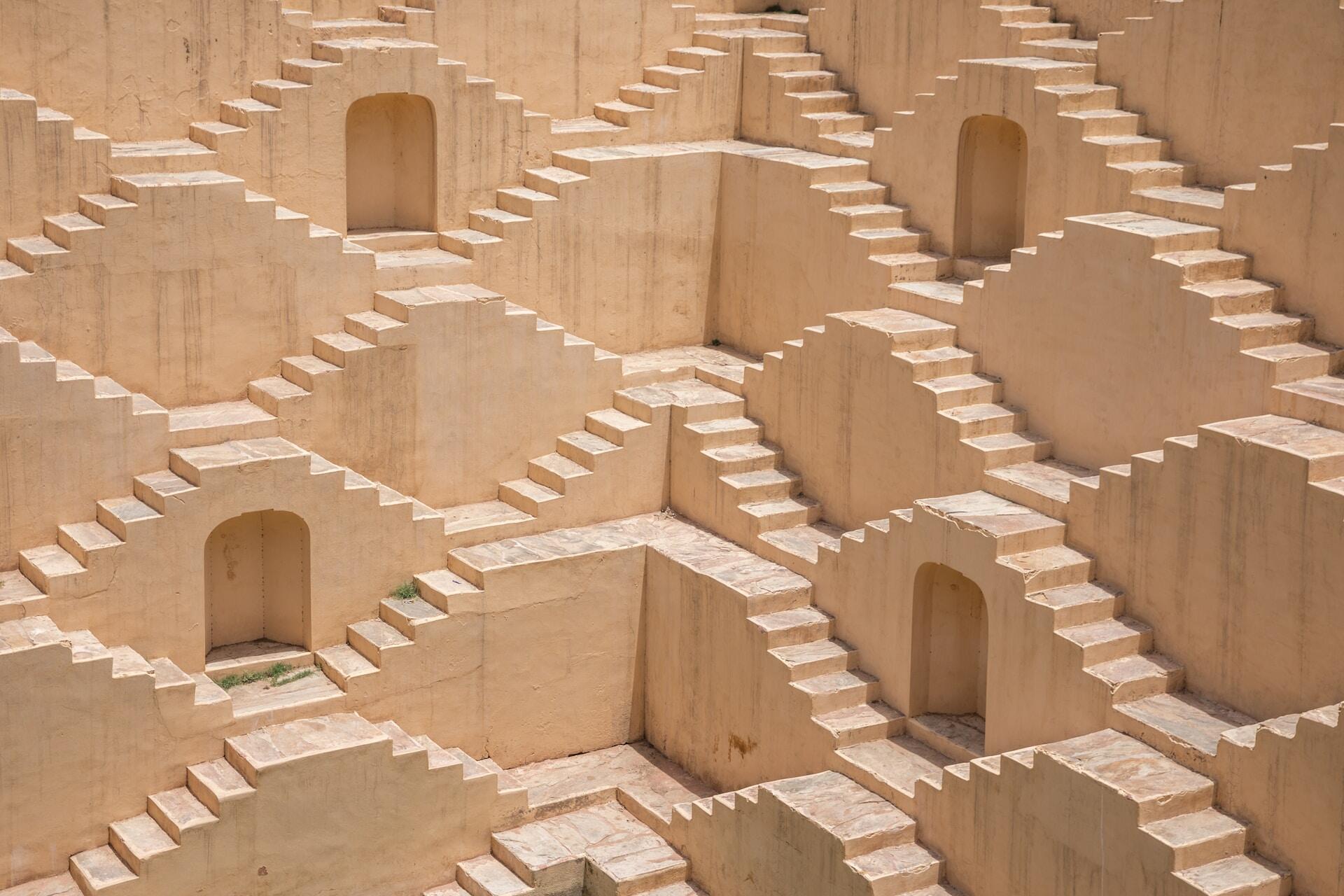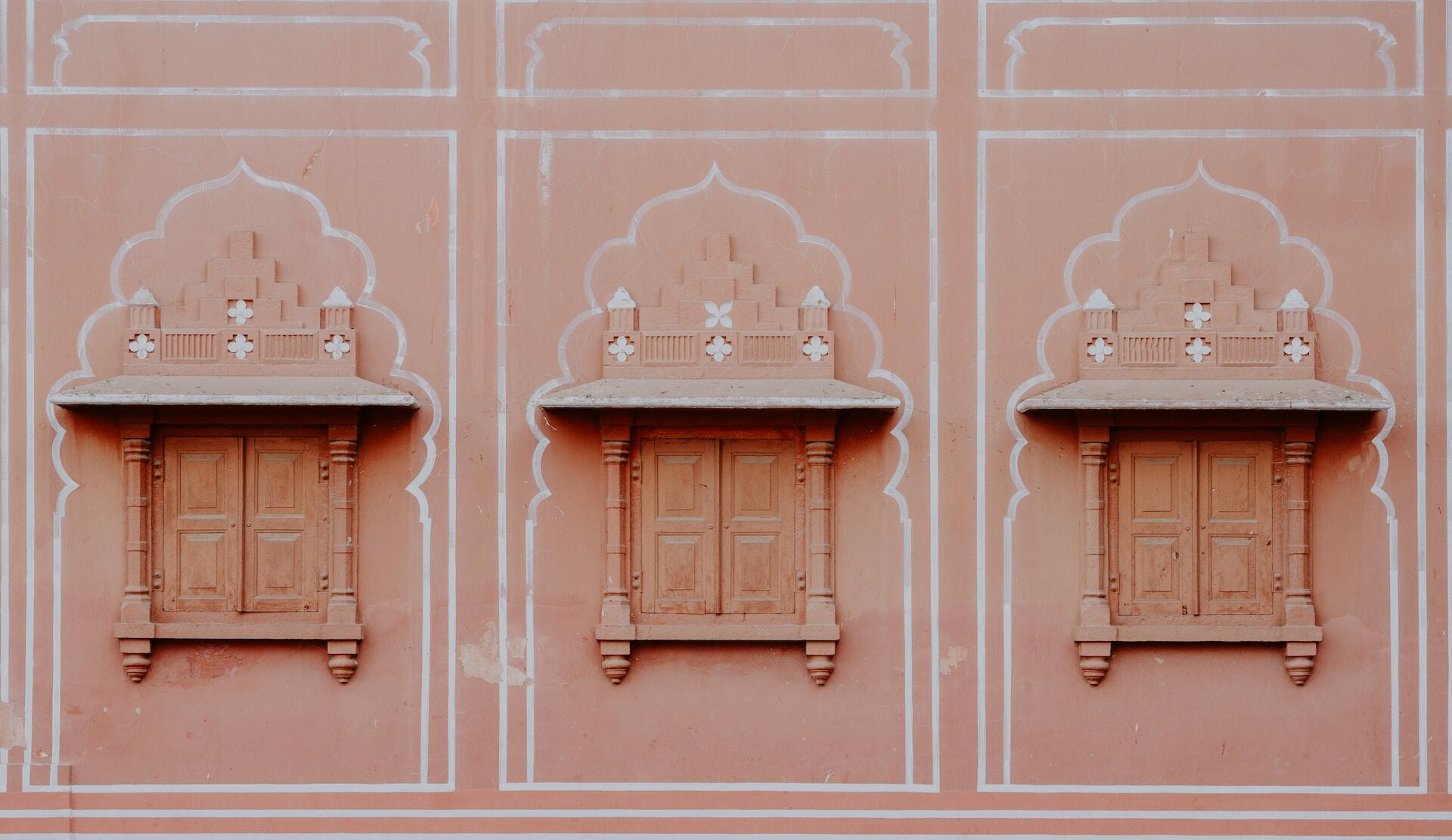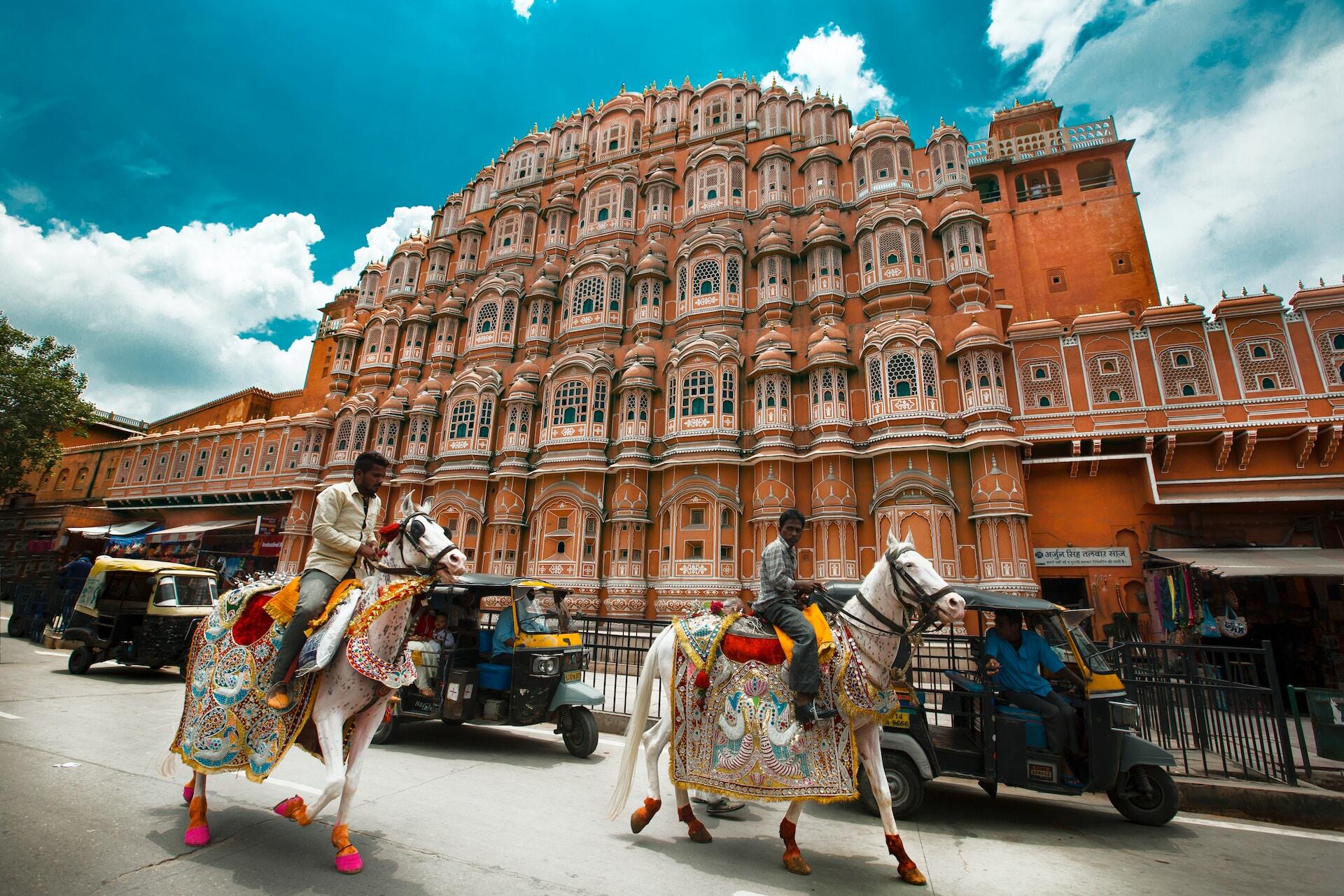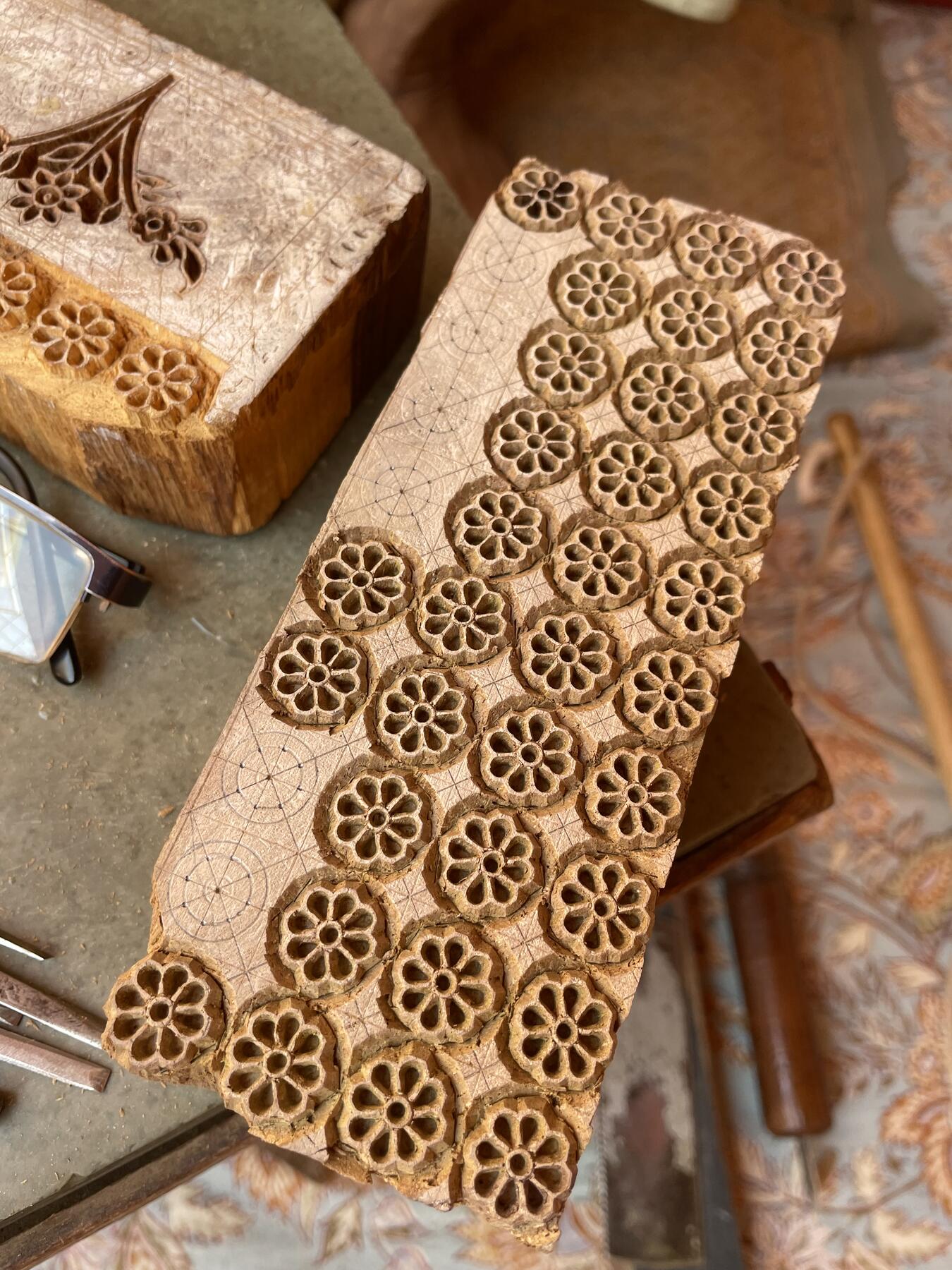Known as the Pink City, Jaipur offers a glimpse of heritage and hospitality that you can expect in Rajasthan.
Incessant beeping and honking were screeching like nails running along a chalkboard, ringing through my ears. A rampage of bikes, e-rickshaws, and cars whizzed past as I trailed cautiously behind my guide, Neeraj Doshi of Heritage Water Walks, through the walled city of Jaipur. More than once, I stayed within the shelter of his frame. He was taming the wild street by showing his hand to the charging traffic without breaking stride.
“Sawai Jai Singh II planned Jaipur in grids. The city has perfect symmetry,” he explains as we began our city tour at 3:30 p.m. on a sunny afternoon. I was bewildered by the chaos and surprised by the irony. In 1727, when Jaipur was built, all details were meticulously planned, from the indomitable city wall and the streets intersecting at right angles, to the ornate gates and the spaces for shops, businesses, and havelis. What the futuristic Maharaja and his architect Vidyasagar Bhattacharya didn’t account for were modern mobile inventions and their noise capabilities.
The History of Jaipur
Jaipur, the capital city of Rajasthan, was India’s first planned city. Maharaja Sawai Jai Singh II was a brilliant man, passionate about architecture and astronomy. Before Jaipur, the hilly region of Amber was the capital of the Mughal empire, but often experienced droughts and couldn’t handle the population explosion (this was the 1700s, mind you). So, the king looked to the flatlands around 12 kilometers away and decided to start anew.
Recommended Fodor’s Video
With his planner and architect, he created a fortified city that would have it all—merchants and traders on the main street, temples and public spaces, a royal residence in the middle of all activity, and most of all, water in the desert.
Seven gates were erected—they still exist—for the entry and exit of residents. Merchants and traders were invited to set up shops and havelis, and neighborhoods were assigned by occupation and caste. But no one was allowed to change the facade—uniformity was paramount. The city grew, as was expected, and soon the nine blocks (nine was an auspicious number) were occupied. At the center was the City Palace (the royal descendants still live there); the Jantar Mantar observatory was located just outside the palace, fitting for the king, who loved astronomy.
A later addition to the area by Sawai Pratap Singh is now the most recognized gem of heritage in the city, the five-story Hawa Mahal. Shaped like the crown of God Krishna, the facade is known for its 953 windows, designed for royal women to watch the streets and processions without being seen from the outside. Now it’s an Instagrammer’s dream stop. Just opposite is the rooftop Tattoo Cafe, which has a snaking line of patrons waiting to shoot the pink-hue palace. The city was built to be a commercial hub, so bazaars (markets) were prime spots for trading.
What You Can’t Miss When Visiting Jaipur
A must-do on any Jaipur itinerary is a stroll in the lanes of Bapu Bazaar, Johri Bazaar (where gems are still cut and renowned jewelers have shops), Tripolia Bazaar, Kishanpol Bazaar, and Chandpol Bazaar. Stop by streetside shops to buy souvenirs or eat dal kachodis. The mansions and temples were designed in a way that the busyness of the city doesn’t reach you when you enter the central courtyard, and the small windows kept the hot, arid winds at bay. This is most noticeable when you reach the gigantic courtyard of Shree Ramchandra Ji Temple, steps from the bazaar down the stairs.
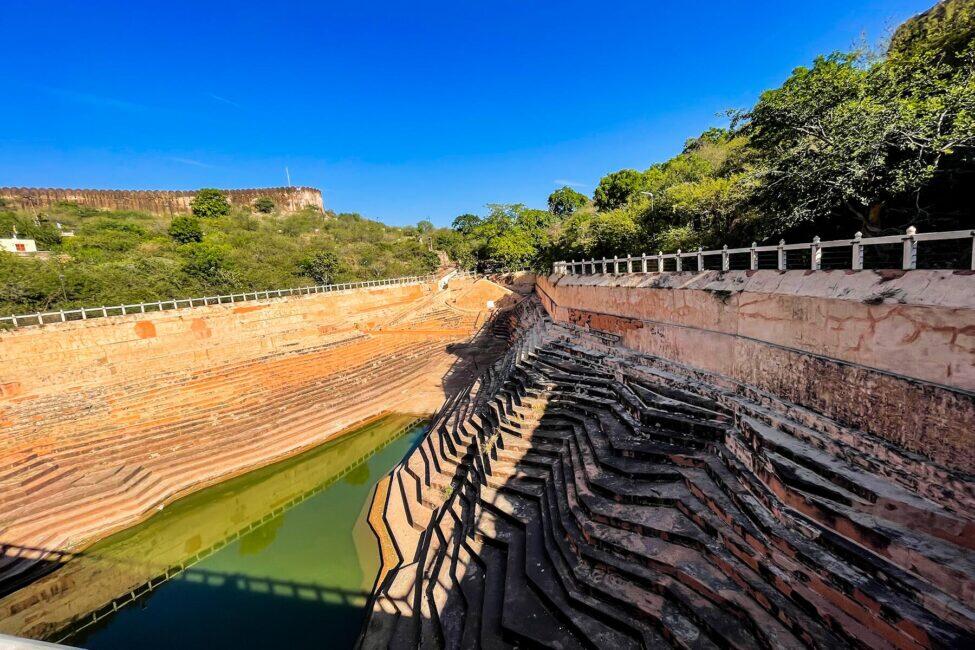
The walled city is on the UNESCO World Heritage List, the ingenuity of the ruler acknowledged by the international agency. It was a strategic move to shift the seat to Jaipur since the hills on its sides offered protection from enemies. One of the lines of defense is the Nahargarh Fort, which was impregnable. It was never attacked but looked out for the city and has been a part of its history for centuries.
Much smaller than the famous Amber Fort (built in 1592 AD), Nahargarh is perched on a hill and flanked by a forest. Its biggest draw is the view of the city from its edge. From this part of Jaipur, you can see straight streets that the founder had envisioned in the 18th century.
It was remarkably quiet, with birds making their company felt and monkeys climbing a stepwell nimbly. It was my second walking tour (yes, I’m a history nerd) with Doshi, and it revolved around the water heritage of the city and how crucial it was to sustain life in the desert. It is still incredible to me how well they planned for water conservation in 1734 when this fort was built. The aqueducts, waterways, and storage tanks were well thought-out. They needed force to let the water flow, but they needed mechanisms to control the pressure—they couldn’t let it damage the walls or overflow into the city. Ingenious!
INSIDER TIPBollywood movie ‘Rang De Basanti’ was shot here and actor Aamir Khan dives into the stepwell that was designed to store up to 12 million gallons of water.
What about the actual fort? Well, I didn’t go in. I didn’t visit any of the massive forts that beckon travelers because I was so enthralled by the alternative tours. Something for next time, perhaps.
It was much easier to appreciate the wide streets and public squares that were the trademark of city planning in the wee hours. The city was still yawning. Doshi had shown me historic photos of processions on the streets and people watching the marches from their rooftops. It was difficult to imagine elephants trotting along royals while squeezing past tires, but the pictures became clearer when the crowds dispersed.
What the Pink City Is Best Known For
Jaipur is a work of art, and colors are everywhere. It’s a photographer’s dream, and sure enough, articles upon articles are dedicated to the most Instagrammable spots. These words may be newfangled, but the city has a long history of creativity and artistry.
The Pink City is famous for blue pottery that uses blue dye to bring nature-inspired motifs (from flowers to birds) to life. Miniature paintings have a Rajasthani flair and involve a lot of detailed work. The traditional block printing technique is still in practice in Sanganer, around 12 kilometers from Jaipur. Lac bangles, bandhani sarees, and gemstone jewelry are lovingly adorned. These aesthetics have been readapted, recreated, and reinterpreted for 21st-century tastes.
Many years ago, I spent an evening in Chokhi Dhani, a mock village around 20 kilometers from the city. It’s an immersive Rajasthani experience; you shop handicrafts, try pottery, watch dance and performances, and eat a traditional thali. This time I found out that renowned muralist and painter Chinmay Mehta designed this resort in 1989 to give a window into Rajasthan’s hospitality, culture, and indigenous arts. He has also produced a Shekhawati mural for a restaurant in London.
Other restaurants and cafes have similarly taken a leaf out of the same art book that is the city. I saw a prime example at ITC Rajputana. The hotel’s lobby stuns you with a stark-white marble staircase. Chandeliers and lamps dangle from the ceiling, and the tiled floor shoulders brick red upholstered furniture. It should all clash, but strangely it works. It has a bar, Sheesh Mahal, inspired by the “palace of mirrors” in Amber Fort, and the red buildings hollow into a central courtyard with a pool area where musical performances are organized every evening. There’s so much of Jaipur here, in the artworks, in the latticework, in the motifs on the wall, and in the evening bazaar.
However, the 250-year-old city is awash with freshness. An old, deeply-rooted tree springing newborn leaves. And the one to share this insider info with me was my friend, Rahul Arora. A Gurgaon native like me, he was in Jaipur to open The Big Tree Cafe; the same cafe in our city was my adda (hangout) in 2020—the pretty-in-white outdoor cafe an escape during the pandemic. But why Jaipur, I asked him when he told me he’s taking his signature 240 kilometers away.
Because Jaipur is very exciting and eclectic, a sentiment others also repeated.
I was given a glimpse into this buzzing world of trendy nightclubs and fancy restaurants in historic nooks and corners. Like Bar Palladio. The name reverberates in the city. Everyone from out-of-towners to locals recommends this Sicily-inspired, electric blue lounge that’s part of a heritage hotel, Narain Niwas Palace. An upcomer is Diona Jaipur. This is a Greece-inspired rooftop lounge with a brewery, the biggest in the country, they claim.
There is something to be said about a city metamorphosed into a firefly after dark. The Albert Hall Museum, Hawa Mahal, Vidhan Sabha, Amber Fort, and Patrika Gate shine brightly. The hustle of Johri Bazaar (jeweler’s market) dulls to a low hum after sunset.
In a lane that I struggled to find on foot (when I told a staff member they were very hard to locate, he smiled and said, “Thank you!”) is The Johri, a five-suite boutique hotel set in a 19th-century haveli. It features a beautiful bar and restaurant—an arch frames twin paintings of birds on either side, and this is another Instagram moment when you walk in. Under the light of a small lamp, with polite and friendly service, we had a modernised-Indian meal of palak patta chaat (spinach chaat), malai broccoli, and kacchi mirch ka paneer (cottage cheese).
The trademark Rajasthani hospitality seems to be making space for every idea, old, novel, and hybrid, and inviting all styles of creative expression. Clearly, if there’s any city that will appreciate Arora’s white-washed interiors with fairy lights, vividly bright dreamcatchers, and a European and modern Indian menu, it’s this.
Yes, the city is still swinging to its own folk music. For the current generation, though, the version is probably Mame Khan’s Chaudhary from Coke Studio, playing on Spotify in havelis and on rooftops.
Mahaarey hivdhey mein jaagi dhaunkani
Rae chandaa main thaari chandni
Maney daaman mein baandhi khusi
Rae jhoom, jhoom, jhoom jhoom baa jhoom
A Quick Guide to Visiting Jaipur for the First Time
How to Get There
Jaipur is part of the Golden Triangle Circuit along with Delhi and Agra. It’s a hop away from the capital city, so you can fly, drive, or take the train. Once here, you will find auto-rikshaws, Ubers, and taxis. Metro also runs in the city.
Where to Stay
Jaipur is mushrooming with hotels. You can choose the luxury palace-hotel, Rambagh Palace, or go for a trendy boutique property like The Johri (it featured in our Fodor’s Finest 2023 list).
I stayed at the homegrown ITC Rajputana that’s known for responsible luxury. The luxury hotel is close to the railway station and has been a trademark in the city for decades. Definitely come here for the food—from the breakfast at Jal Mahal to dal bhatti choorma at Jaipur Pavilion to butter chicken and naan at Peshawri, every meal is memorable here.
What to Do
Learn about hand block printing at Anokhi Museum by Jaipur-based clothing brand Anokhi. It is set in a haveli and has lovely, informative displays on the art and history of block printing and how it has been reimagined by contemporary designers. Demonstrations by Anokhi artists are a must-see.
Drop by the ICA Gallery, close to Jal Mahal. Here on display are local and Indian artists (Chinmay Mehta’s works are also exhibited). The gallery runs art programs and has local artists making paintings on its top floor.
In January, you can attend the famous Jaipur Literature Festival, which brings authors, poets, and book lovers from around the world to this city. Lots of talks and events are planned.
Where to Eat
Tapri Central in C-Scheme is a rooftop chai lounge with indoor and outdoor seating, and it is perpetually busy. If you get a table on the terrace, watch the setting sun over a masala chai and chaat—it’s another one of those places worth the hype, where the food complements the ambiance and the service is impeccable. The Tapri store on its lower floor is a good place to pick up local handicrafts, tea blends, and cool decor from artisans all over India.
Indian Coffee House is a highly recommended cafe. You can watch a musical or dance performance at the Jawahar Kala Kendra and head to the cafe for an unassuming meal of dosa and coffee.
Where to Shop
Every street and shop corner is inviting. From blue pottery tiles and crockery to beautiful sarees to gorgeous pieces of jewelry and lac bangles, you will have a hard time saying no. Some of the brands you can visit are Amrapali for elegant precious stone and silver jewelry, Teatro Dhora for sustainable fashion, and Rukhmani Jaipur for high-end designer sarees. If food is your jam, buy kachodis and jalebis from Samrat and gajjak from Ishwarji—both are in the same lane in Bapu Bazaar.

